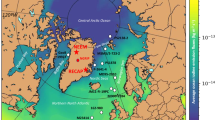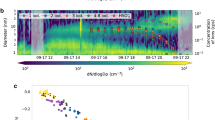Abstract
Naturally occurring bromine- and iodine-containing compounds substantially reduce regional, and possibly even global, tropospheric ozone levels1,2,3,4. As such, these halogen gases reduce the global warming effects of ozone in the troposphere5, and its capacity to initiate the chemical removal of hydrocarbons such as methane. The majority of halogen-related surface ozone destruction is attributable to iodine chemistry2. So far, organic iodine compounds have been assumed to serve as the main source of oceanic iodine emissions1,6,7,8,9. However, known organic sources of atmospheric iodine cannot account for gas-phase iodine oxide concentrations in the lower troposphere over the tropical oceans3,4. Here, we quantify gaseous emissions of inorganic iodine following the reaction of iodide with ozone in a series of laboratory experiments. We show that the reaction of iodide with ozone leads to the formation of both molecular iodine and hypoiodous acid. Using a kinetic box model of the sea surface layer and a one-dimensional model of the marine boundary layer, we show that the reaction of ozone with iodide on the sea surface could account for around 75% of observed iodine oxide levels over the tropical Atlantic Ocean. According to the sea surface model, hypoiodous acid—not previously considered as an oceanic source of iodine—is emitted at a rate ten-fold higher than that of molecular iodine under ambient conditions.
This is a preview of subscription content, access via your institution
Access options
Subscribe to this journal
Receive 12 print issues and online access
$259.00 per year
only $21.58 per issue
Buy this article
- Purchase on Springer Link
- Instant access to full article PDF
Prices may be subject to local taxes which are calculated during checkout



Similar content being viewed by others
References
Vogt, R., Sander, R., von Glasow, R. & Crutzen, P. J. Iodine chemistry and its role in halogen activation and ozone loss in the marine boundary layer: A model study. J. Atmos. Chem. 32, 375–395 (1999).
Read, K. A. et al. Extensive halogen-mediated ozone destruction over the tropical Atlantic Ocean. Nature 453, 1232–1235 (2008).
Mahajan, A. S. et al. Measurement and modelling of tropospheric reactive halogen species over the tropical Atlantic Ocean. Atmos. Chem. Phys. 10, 4611–4624 (2010).
Jones, C. E. et al. Quantifying the contribution of marine organic gases to atmospheric iodine. Geophys. Res. Lett. 37, L18804 (2010).
Saiz-Lopez, A. et al. Estimating the climate significance of halogen-driven ozone loss in the tropical marine troposphere. Atmos. Chem. Phys. Discuss. 11, 32003–32029 (2011).
Law, K. S. & Sturges, W. T. Scientific Assessment of Ozone Depletion: 2006, Global Ozone Research and Monitoring Project, Report No. 50 Ch. 2 (World Meteorological Organization, 2007).
Liss, P. S. & Slater, P. G. Flux of gases across the air–sea interface. Nature 247, 181–184 (1974).
Davis, D. et al. Potential impact of iodine on tropospheric levels of ozone and other critical oxidants. J. Geophys. Res. 101, 2135–2147 (1996).
Carpenter, L. J. Iodine in the marine boundary layer. Chem. Rev. 103, 4953–4962 (2003).
Garland, J. A. & Curtis, H. Emission of iodine from the sea surface in the presence of ozone. J. Geophys. Res. 86, 3183–3186 (1981).
Sakamoto, Y., Yabushita, A., Kawasaki, M. & Enami, S. Direct emission of I2 molecule and IO radical from the heterogeneous reactions of gaseous ozone with aqueous potassium iodide solution. J. Phys. Chem. A 113, 7707–7713 (2009).
Hayase, S., Yabushita, A. & Kawasaki, M. Heterogeneous reaction of gaseous ozone with aqueous iodide in the presence of aqueous organic species. J. Phys. Chem. A 114, 6016–6021 (2010).
Ganzeveld, L. et al. Atmosphere-ocean ozone exchange: A global modeling study of biogeochemical, atmospheric, and waterside turbulence dependencies. Glob. Biogeochem. Cycles 23, GB4021 (2009).
Clifford, D. & Donaldson, D. J. Direct experimental evidence for a heterogeneous reaction of ozone with bromide at the air–aqueous interface. J. Phys. Chem. A 111, 9809–9814 (2007).
Garland, J. A., Elzerman, A. W. & Penkett, S. A. The mechanism for dry deposition of ozone to seawater surfaces. J. Geophys. Res. 85, 7488–7492 (1980).
Magi, L. et al. Investigation of the uptake rate of ozone and methyl hydroperoxide by water surfaces. J. Phys. Chem. A 101, 4943–4949 (1997).
Rouvière, A., Sosedova, Y. & Ammann, M. Uptake of ozone to deliquesced KI and mixed KI/NaCl Aerosol Particles. J. Phys. Chem. A 114, 7085–7093 (2010).
Davidovits, P. et al. Mass accommodation and chemical reactions at gas–liquid interfaces. Chem. Rev. 106, 1323–1354 (2006).
Guo, Z. N. & Roache, F. Overall mass transfer coefficient for pollutant emissions from small water pools under simulated indoor environmental conditions. Ann. Occup. Hyg. 47, 279–286 (2003).
Johnson, M. T. A numerical scheme to calculate temperature and salinity dependent air–water transfer velocities for any gas. Ocean Sci. 6, 913–932 (2010).
Truesdale, V. W., Luther, G. W. & Canosa-Mas, C. E. Molecular iodine reduction in seawater: An improved rate equation considering organic compounds. Mar. Chem. 48, 143–150 (1995).
Margerum, D. W. et al. Kinetics of the iodine monochloride reaction with iodide measured by the pulsed-accelerated-flow method. Inorg. Chem. 25, 4900–4904 (1986).
Wang, Y. L., Nagy, J. C. & Margerum, D. W. Kinetics of hydrolysis of iodine monochloride measured by the pulsed-accelerated- flow method. J. Am. Chem. Soc. 111, 7838–7844 (1989).
Faria, T., Lengyel, D. B., Epstein, I. R. & Kustin, K. Combined mechanism explaining nonlinear dynamics in bromine(III) and bromine(IV) oxidations of iodide ion. J. Phys. Chem. 97, 1164–1171 (1993).
Reeser, D. I. & Donaldson, D. J. Influence of water surface properties on the heterogeneous reaction between O3(g) and I−(aq) . Atmos. Environ. 45, 6116–6120 (2011).
Frew, N. M. et al. Air-sea gas transfer: Its dependence on wind stress, small-scale roughness, and surface films. J. Geophys. Res. 109, C08S17 (2004).
Nightingale, P. D. et al. In situ evaluation of air–sea gas exchange parameterizations using novel conservative and volatile tracers. Glob. Biogeochem. Cycles 14, 373–387 (2000).
Saiz-Lopez, A. et al. Atmospheric chemistry of iodine. Chem. Rev. 112, 1773–1804 (2011).
Acknowledgements
We acknowledge the UK NERC SOLAS (Surface Ocean Lower Atmosphere) programme for funding and would like to thank J. Lee, University of York, for loan of the O3 generator and monitor. M.D.S. and S.M.M. thank the NERC for the award of PhD studentships. S.M.M. would also like to thank Vanessa Cox for assistance with the University of Leeds experiments.
Author information
Authors and Affiliations
Contributions
L.J.C. and J.M.C.P. designed the experiments and S.M.M., M.D.S., R.K. and R.W.S. carried them out. L.J.C. designed and implemented the interfacial model and interpreted the data. R.P. developed some of the aqueous iodine mechanism used in the interfacial model and performed aqueous iodine experiments to validate it. J.M.C.P. carried out the atmospheric modelling. J.W. performed the linear regression modelling. L.J.C. prepared the manuscript, with contributions from all authors.
Corresponding authors
Ethics declarations
Competing interests
The authors declare no competing financial interests.
Supplementary information
Supplementary Information
Supplementary Information (PDF 1292 kb)
Rights and permissions
About this article
Cite this article
Carpenter, L., MacDonald, S., Shaw, M. et al. Atmospheric iodine levels influenced by sea surface emissions of inorganic iodine. Nature Geosci 6, 108–111 (2013). https://doi.org/10.1038/ngeo1687
Received:
Accepted:
Published:
Issue Date:
DOI: https://doi.org/10.1038/ngeo1687
This article is cited by
-
Natural short-lived halogens exert an indirect cooling effect on climate
Nature (2023)
-
The gas-phase formation mechanism of iodic acid as an atmospheric aerosol source
Nature Chemistry (2023)
-
Climate changes modulated the history of Arctic iodine during the Last Glacial Cycle
Nature Communications (2022)
-
Reactive halogens increase the global methane lifetime and radiative forcing in the 21st century
Nature Communications (2022)
-
Molecular dynamics simulations of the evaporation of hydrated ions from aqueous solution
Communications Chemistry (2022)



